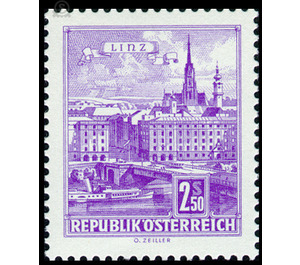Structures - Austria / II. Republic of Austria 1962 - 2.50 Shilling
Theme: Architecture
| Country | Austria / II. Republic of Austria |
| Issue Date | 1962 |
| Face Value | 2.50 |
| Color | violet |
| Printing Type | offset |
| Stamp Type | Definitive |
| Item Type | Stamp |
| Chronological Issue Number | 461 |
| Chronological Chapter | OOS-OE2 |
| SID | 461705 |
| In 122 Wishlists | |
Immediately before entering a wide depression, the Danube breaks through the romantic narrow masses of the Mühlviertler massif, fringed by rock formations and forests. It spreads, slows down the run, pours up gravel and thus makes a transition possible. Already the Roman occupying forces recognized this strategically important point in the area of today's city Linz, and so on the slope of the Roman mountain an observation post of a rider department was created. Outside the camp, civilians settled in supplying the military, as well as craftsmen and traders. They formed the actual beginning of a closed settlement, which the Romans called Lentia in reference to a Celtic word. From the Middle Ages important buildings have been preserved, such as the imperial city palace. The towering structure of the castle, Friedrich III., Towers above Linz. At the end of the Middle Ages, Linz made Linz the capital and capital of the "Holy Roman Empire of the German Nation". It was extended and particularly decorated by Rudolf II in the 16th century, because at his feet the state estates erected a palace, one of the most important Renaissance buildings in Austria, the Linzer Landhaus. The change to today's modern industrial city, which was mainly favored by the location on the Danube River, began in the 19th century.


